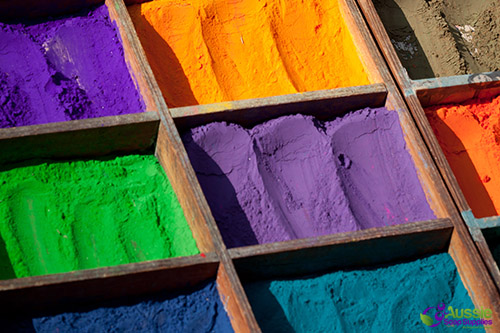Choosing the right colour for the right product can be a little confusing. We have put together this overview to help you understand the differences between the types of colours.
We have been selling colours to soapers and cosmetic formulators since 2001 and have tested every colour we sell. There are several grades of colours and the technical and cosmetic standard colourants are usually more expensive than industrial or lower grades.
Basic Groups
Though we do not cover chemistry here, you can reduce the basic groups to Organic and Inorganic. The term ‘inorganic’ in this instance has nothing to do with the quality or purity of the colour. It means that they do not have a carbon molecule in their makeup, whereas organic colours are insoluble metallic compounds mostly derived from natural sources (ie china clay, carbon deposits), though they are also synthesised.
Organic colours include: FD & C Dyes including water and oil soluble, lakes and carmines (carmine by nature, not name).
Inorganic colours include: Iron Oxides, Ultramarines, Chromium Oxide, Titanium Dioxide, Ferric Ferrocyanide (a blue which tends to morph at high pH).

Pigments
Ultramarines: These are cosmetic grade pigments so they won’t bleed or migrate when used in your soap. Hydrate these powders, in some water, glycerine or oil prior to adding to soap to avoid speckling.
Product Suitability:
Suitable for: All bar or solid soap, mineral make up, hair powders, Melt & Pour Soap if hydrated or as Colour Blocks.
Not Suitable for: Lotions and creams, liquid soap or body wash/shampoo, body butters, candles, lip balm, body or bath oils.
Oxides: This family of colours are strong, powdered pigments. They are highly refined and purified to make them suitable for use on the skin. They are processed, refined and cleaned and this distinguishes them from the oxides used for pottery and paints that contain heavy metals and other impurities making them very cheap. Non cosmetic (pottery grade) oxides are NOT suitable for skin care products. As these are closer to natural there will be colour variation similar to that found in natural clays from batch to batch. Hydrate these powders in some water prior to adding to soap to avoid speckling. As oxides are pigments, they won’t bleed, mutate or migrate when used in your soap.
Product Suitability:
Suitable for: All bar or solid soap, some mineral make up, hair powders
Not Suitable for: Liquid soap or body wash/shampoo, lotions, creams, body butters, candles, body or bath oils.
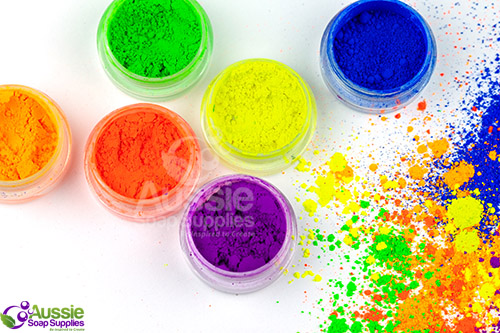
Neons and Fluro’s: Our Brite Liquid Colours and Neon Pigments are also known as ‘fluro’s. The Liquid Brites are a liquid form of pigment in “Neon” colours. We stock a range of fluorescent liquid pigments for Cold Processed Soap and Melt & Pour Soap as well as powdered Neon Pigments for Melt & Pour Soap and powders. Brites for CP are not as concentrated as Liquid Neons, but do behave better in Cold Process Soap.
Product Suitability: All are suitable for bar soap in different forms, but do read individual usage information.
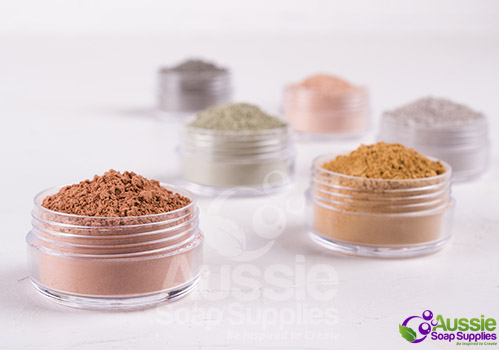
Cosmetic Clays are pigments and don’t fade or bleed. They will give muted, earthy colours to products. Extra care with preservation is required if being used in an aqueous product (this does not include soap).
Product Suitability: Please read individual listings for products other than soap – they are suitable for all bar soaps.

Cosmetic Mica Powders
Our Micas are high grade, cosmetic colours. Some are pure pigments, some a mixture of pigments and dyes, so they do fall into both categories. Micas need light to be reflected to be seen at their best. If you wish to highlight your colour, just add a white pearlescent Mica and it will pearlise any of your colours. There is now a huge range of micas available, all with their own attributes.
Product Suitability: As a rule of thumb they are suitable to use in all cosmetic applications and soap. However, for lip products and soap, check individual listings for exclusions. Due to the dye content of some micas, they may bleed or morph in high pH products. Be sure to check in a small test batch if the website does not have the test details. For lip products, not all micas are Lip Safe – individual listings have details.
Lakes Dye or pigment? Hmm, they are dyes (“laking” is actually a process) made by absorbing the dye on a substrate of pigment. This means they will bleed less in your soap, but will still bleed and fade a little as they behave similarly. These include some FD & C colours, but not all. Lakes are less prone to fading than regular FD & C colours and may be water or oil miscible.
Product Suitability:
Suitable for: Many products, but for specifics please refer to the actual product page as they can differ widely. We use them in bath bombs, bar soaps, bubble bars and anhydrous products. However, if using the the liquid versions of our dyes, please check the usage on individual colours.
Not Suitable for: Water based products (as a rule of thumb).

FD & C Colours
Three letters that stand for: Food, Drugs & Cosmetics – and are approved for use in those products. These are dyes, and are suitable for soap as well as cosmetics and lip balms. FD & C colours will bleed in soap products, and also fade. Product suitability will depend on whether they are oil or water soluble FD & C’s.
Product Suitability:
Suitable for: We use them in bath bombs, liquids and all kinds of soap *high pH soapers check the usage information for Brilliant Blue (FD & C #1). It is best to add Polysorbate 80 to bath bombs to help the colour rinse away easily.
Not Suitable for: High light locations of product, ie sun exposure – check if you are using an oil or water soluble colour.
The following are sub categories of the above:
- D & C Colours: = Drugs & Cosmetics, (but NOT foods or lip products) – you can see the theme! Suitable for soap!
- Ext. D & C Colours: As the name implies, for use in externally applied Drugs & Cosmetics that DO NOT come in contact with mucous membranes or lips – not suitable for lip colours. Suitable for soap.
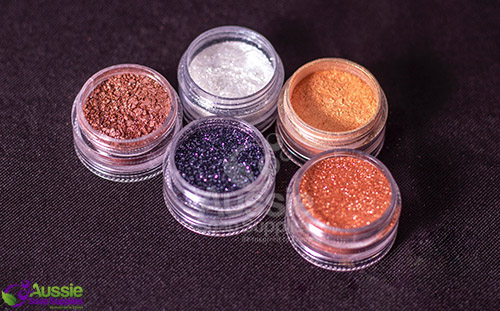
Bio and Eco Glitters are mostly cellulose and some contain PLA. Bio Glitters are 100% biodegradeble. All glitters should be trialed in aqueous products and colours used in clear soap only if you want the sparkle, or on top of white soap and Cold Process Soap. Testing is recommended. Aussie Soap Supplies do not stock plastic glitters or scrubs.
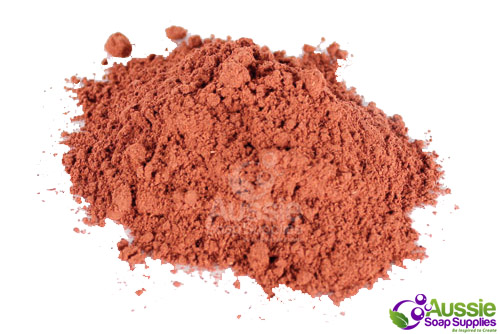
Botanical colourants are considered to be dyes, and are not regulated to be of a cosmetic standard. However, they are hugely popular colourant for soap and spa products. They often morph or fade, so it’s always a good idea to test any botanical dyes in a trial batch of soap. Botanical dyes can give some unexpected results!

Candle Colours are usually solvent based dyes, and MUST NOT BE USED ON THE SKIN AT ALL, ever. As they are not to be used for cosmetic or personal care products they are not regulated – beware. Pigments are not always suitable, especially at high concentration in wicked candles, though we have used a number of our micas and had no issues in all our trials.
Can I Mix Pigments and Dyes Together?
YES! There is no problem mixing dyes with pigments to make the colour you desire. But remember, if you add a dye, to a pigment, the dye component of that blend may have a tendency to migrate in Melt and Pour Soap.
Will they keep?
Our powdered colours will last indefinitely if kept in a sealed opaque or dark container. If it is in a translucent container, store inside a cupboard. This ensures the product stays at its best for the longest time.
Once powdered colours are mixed with water, (please use distilled water) be aware this will grow bacteria/fungi (like a lotion without a preservative) eventually. If suspended in oil or glycerine, the normal shelf life of the medium applies. If stored for a period of time without use, liquid colours will need a good shake or stir as the pigment or dye will settle.
Our liquid colours, have a shelf life of 2 – 3 years minimum, usually much longer if stored well.
Some finer details….
Of the above listings, some of the FD & C, D & C and Ext D & C are used in pharmaceuticals, baby products, soaps, bath/oral/hair/nail products, makeup, and fragrance – but not all from each group are permissible in all categories. For instance, FD & C Blue No. 1 is permissible in each category, as is F D & C Yellow Nos. 5 & 6, but FD & C Red No. 4 is NOT allowable in pharmaceuticals, bath products & oral products, but IS allowable in baby products.
This can be very confusing to begin with, but we have included the above paragraph to indicate the complexities involved in colour regulation.
To add to the confusion, depending on the application, the same pigment or dye can give amazingly different results. Further considerations are the colour of your base, pH and method of production. A colourant can be a dye in one medium and a pigment in another (ie FD & C Yellow No. 5 is a dye in water and a pigment in oil). So even though we have tested and tried ALL the colours we sell, we still urge you to sample test before using in an important or large project.
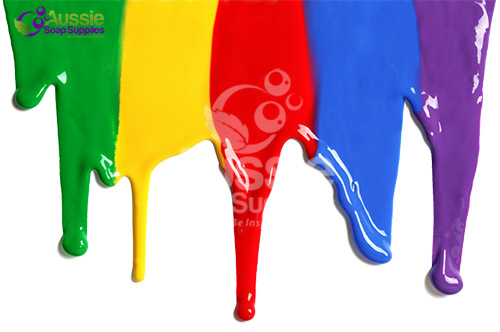
“Pigments are insoluble in the medium in which they are used.” The term pigment with reference to our colours refers to colours that will not bleed or mutate in your Melt & Pour Soap or Cold Process soap. If the word “Pigment” is in the name and description, this won’t bleed in your soap.
“Dyes are soluble in the vehicle in which they are used – ie dissolved in alcohol, glycerine, water, oil.” Dyes tend to be more vibrant colours, but are not the “Neon” colours (Brites).
Lakes are very stable in Melt & Pour Soap and we have had only a little bleeding or colour migration. Pigments are the best for Melt & Pour, no bleeding. Creative projects do sometimes require the migration of colour, so each does have its place.
As a general rule dyes will be much more likely to migrate or bleed in Melt & Pour Soap and are also more likely to be affected by pH of Cold Processed Soap. We have chosen the most stable FD & C dyes to stock.
Australia does not have the same regulations as the USA, EU, Japan, UK etc. Australian regulatory authorities regard soap as a “Cosmetic Product”. This means the colour you choose should not be industrial or commercial grade. There are still many colours from the USA, India and China that are NOT permitted to be used in soap in Australia, the EU and UK. “Soap safe” does not mean skin safe, it just means you can mix them into soap. Standards are always being revised making it easier to comply. We are often asked about “Personal Care Liquid Colours” – we cannot offer any advice as that name is too generic and doesn’t give enough information. They are not something we have sought or seen from our manufacturers and importers. It is best to ask to view the INCI and/or Specification from the onseller.
You can find further information on Colour Additives used in cosmetic products on this Link to COSMETICS INFO ORG
© Aussie Soap Supplies® 2014, Updated 2021.

